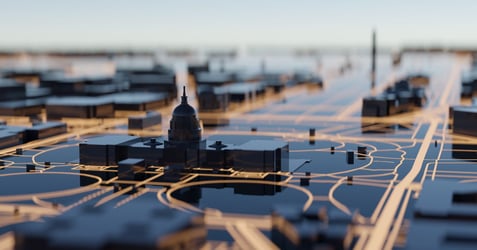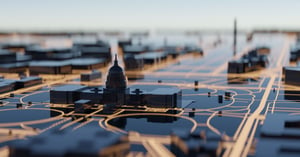Twins are “two offspring produced by the same pregnancy” – but they can also be made up of two similar or connected members, as is the case with digital twins. This concept has taken urban planning by storm. Read more about digital twins for cities and how this technology can help future-proof our settlements.
Future-proofing cities with a smart model

Current headlines about heatwaves in Europe prove that extreme weather events as the result of climate change pose some of the greatest risks known to humanity. Heat, but also storms and floods endanger human health and safety, the biodiversity of our planet, and urban infrastructures. There are countless approaches to making cities more resilient. But especially in smart cities, the question is how to better leverage our data to increase urban climate resilience. Digital twins are a potential answer.
A digital twin is a simulation technology that offers a 3D model with 4D spatial data of a city. It is a tool of the future city that helps to identify areas of intervention, locate opportunities, and make informed decisions on how to climate-proof a city, for example through heat mitigation and sponge city effects for excess water. The digital twin of a city is accessible on a computer in special software, which analyses data on a city’s built environment, its land use, and weather patterns. It can cross-reference datasets and provide many layers of information that help to prioritise city planning efforts. A good example is the SIM-CI Digital Twin City simulation platform, which helps cities prepare for high-risk situations.
On paper, future-proofing our cities sounds easy: Add more nature, make the city greener, ensure a sponge effect, provide shadow, create habitats, and improve quality of life. But the implementation looks different in every city, and every city has its unique challenges in becoming more resilient. With a digital twin serving as a decision-making and planning tool, it is possible to leverage the power of data to reduce the Urban Heat Island effect, decrease energy consumption, work on cleaning up the air, and decide where to place interventions like permeable pavements, green roofs, or reflective rooftops.
💡Reading tip: How the Urban Heat Island Effect is harming our cities
Improving urban resilience against climate change effect
So, digital twins are replicas of physical systems that help to monitor, analyse, and predict the effects of climate change (and other influences). The replicas of cities can also provide real-time data on a city’s infrastructure, showing events such as higher-than-average temperatures or traffic jams. In the context of high summer temperatures, a digital twin can alert city officials to endangered areas and cross-reference them with the average age of inhabitants of the affected area, for example. This would make it possible to effectively deploy help to vulnerable parts of the population in the short term and to improve infrastructure in the midterm.
For other extreme weather events like floods or hurricanes, digital twins also help. They can provide real-time 4D spatial data of the city and its infrastructure with IoT technology like sensors and cameras. This way, city leaders can anticipate and prepare for extreme weather events, for example by developing strategies to reduce the risk of flooding or implementing actions on storm-proofing an endangered neighbourhood.
But digital twins of cities are also helpful beyond disasters: They can monitor the air quality and pollution levels in a city, keep an eye on water resources, and help reduce and improve energy usage. This way, cities can identify areas where they don’t work as efficiently as they could, and then reduce their overall carbon footprint. They also help planners decide where to build new infrastructure by modelling the effects that decisions like building a new bridge, improving drainage systems or rehabilitating a waterfront would have.
Good data is key
Sounds good, right? In case you are wondering why not every city has a digital twin already, here are some of the barriers to this technology. To have a useful digital twin of a city, we rely on mature technologies and data, and many cities don’t have that. An urban digital twin is more than a digital replica of the city. It also uses sensors, alarms, and cameras to create a connected city and then adds a layer of artificial intelligence and simulations to reach a truly smart digital twin of a city.
To create this twin, cities need reliable data, a good network of sensors and similar technology, a welcoming legal framework, and the funds to afford the necessary hardware and software. Digital assets also require consistent upkeep and reliable observation, as well as time for the documentation of real-time changes. Most challenges for cities that want to establish a digital twin relate to data, but ownership, participatory feedback, and capacity building are also not easy.
At the same time, climate change effects are already showing relentless and devastating effects on many cities. To build up a digital twin, good organisation, and a structured approach. In the middle of a crisis, this is difficult to muster. Still, a digital twin would provide city planners and everyone else involved in improving urban resilience a great starting point for priority setting, action-taking, and outcome monitoring.
500 Urban Digital Twins by 2025
Digital twins of cities are an important part of the future smart city. These intelligent models help city leaders and planners to develop strategies for adapting to the effects of climate change, to make smarter decisions for infrastructure, and to decrease the city’s carbon footprint. By modelling different scenarios and cross-referencing data, it is possible to make a city more resilient and to protect vulnerable populations. In the long term, these twins can make cities much more sustainable.
But let’s not forget that digital twins, like all smart city technologies, are a tool. They are only as good as the data they rely on, and they need a welcoming political environment as well as a bundle of other actions to unfold their full potential. Cities like Stuttgart in Germany, Tallinn in Estonia, and Des Moines in the US have launched their digital twins. Already, they are in use to identify solar panel locations in Singapore, direct people flow at train stations in London as well as to simulate the impact of natural disasters in Seoul. According to Cities Today, there might be over 500 urban digital twins in 2025, saving cities billions of Euros through more efficient urban planning and less damage from climate change.
Find more inspiring solutions on our global smart city platform
Join the largest smart city online network and community for free and get in contact with more than 15.000 members worldwide. Discover hundreds of solutions and connect with other smart city enthusiasts to share knowledge, discuss trending topics and forge new partnerships.


